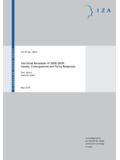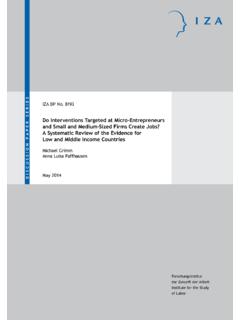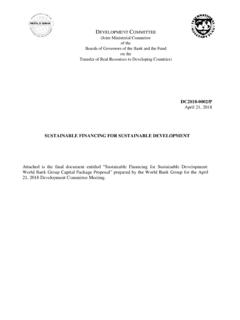Transcription of Funding Mechanisms for Financing Vocational Training: An ...
1 IZA Policy Paper No. 110. PO LI CY PAPE R S E R I E S. Funding Mechanisms for Financing Vocational training : an analytical Framework Adrian Ziderman April 2016. Forschungsinstitut zur Zukunft der Arbeit Institute for the Study of Labor Funding Mechanisms for Financing Vocational training : an analytical Framework Adrian Ziderman Bar-Ilan University and IZA. Policy Paper No. 110. April 2016. IZA. Box 7240. 53072 Bonn Germany Phone: +49-228-3894-0. Fax: +49-228-3894-180. E-mail: The IZA Policy Paper Series publishes work by IZA staff and network members with immediate relevance for policymakers. Any opinions and views on policy expressed are those of the author(s). IZA takes no institutional policy positions. The IZA research network is committed to the IZA Guiding Principles of Research Integrity. The Institute for the Study of Labor (IZA) in Bonn is a local and virtual international research center and a place of communication between science, politics and business.
2 IZA is an independent nonprofit organization supported by Deutsche Post Foundation. The papers often represent preliminary work and are circulated to encourage discussion. Citation of such a paper should account for its provisional character. A revised version may be available directly from the corresponding author. IZA Policy Paper No. 110. April 2016. ABSTRACT. Funding Mechanisms for Financing Vocational training : an analytical Framework*. The paper provides an account of innovative Financing Mechanisms which have been adopted in many national training systems. These Mechanisms aim at correcting shortcomings of conventional training finance systems in order to better meet labor market needs, improve both the quality and relevance of training provision and to contain training costs. Directions of change include a greater diversification of Funding sources for skills development (including cost sharing and training levies, mainly based on company payrolls), budgeting public training centres through objective Funding formulas, encouraging more and higher quality enterprise training , the development of private training markets, increased competition between public and private training providers and the establishment of independent national training funds.
3 Autonomous national training authorities, with broad powers and sizeable stakeholder representation, can be effective in both coordinating and steering national training systems. JEL Classification: I22, J08, J24. Keywords: demand-driven training , Funding training institutions, individual learning accounts, Levy-Grant Schemes, national training authorities, payroll levies, private training provision, training finance, training funds, training subsidies, training taxes Corresponding author: Adrian Ziderman Economics Department Bar-Ilan University 52900 Ramat Gan Israel E-mail: *. This paper draws extensively on Ziderman (2003 and 2010), providing both an update and broadened regional coverage. Introduction Vocational training is a vital component of the drive to enhance productivity, stimulate economic development and competitiveness, to reduce the incidence of unemployment and to lift disadvantaged groups out of poverty.
4 However, training provision in many countries is underfinanced and fragmented and, as a consequence, fails to meet the skill needs of the economy and of society as a whole. A central theme of this paper is that the system of training finance (and, in particular, its constituent Financing Mechanisms ) has a twofold purpose. Not only does it supply Funding for the various elements of the national training system but, if appropriated fashioned and executed, can play a central role in leading to a more efficient, competitive, market oriented national training system. Thus the paper emphasizes the central role that Financing strategies can (and should) play in enhancing the effectiveness and efficiency of training systems, through incentives, greater competition amongst training providers and the integration of private and public provision This paper is addressed not only to an academic audience, but also to policy makers and practitioners of Vocational training , who must deal with the adaption of the national training system to meet national and social needs, in the face of ongoing technological change, globalization and increased international competition.
5 In Section 2 that follows, a schematic presentation is provided of training -finance flows in conventional, fragmented training markets. This section provides a setting for the need to move away from traditional Financing systems towards innovative Financing Mechanisms that are increasingly being adopted in national training systems worldwide. These moves aim both at correcting shortcomings of conventional training finance systems in terms of better meeting labor market needs and containing training costs and also to meet the national challenges of competition, technological change and globalization. Five directions of change are discussed, respectively in Sections 3 to 6. A major direction of change is to be seen in moves to diversify Funding sources for skills development. These include firstly, enhanced cost sharing through training levies on enterprise and, secondly, the introduction or increase of tuition fees for trainees; these two developments are discussed in Section 3.
6 A third development is the encouragement, by suitable incentives, of more and higher quality training by companies (Section 4). Fourthly, moves to improve the efficacy of the training provided by training institutions are strongly in evidence: these include the increasing adoption of objective formula Funding for public institutions, the development of private training markets and increased competition between public and private training providers (Section 5). Section 6 focusses on a relatively new type of Financing mechanism: the national training fund, which in many countries operates within a broader remit as a national training authority. The advantages and risks of these institutional Mechanisms will be discussed The concluding Section 7 summarizes the discussion. It does so through the presentation of a schematic account of finance flows that integrates these innovative Financing 2.
7 Mechanisms within a unified system, with the aim of facilitating the desired development of integrated, competitive, demand-driven training markets There is relatively little discussion in this paper of the Financing of Vocational education provided within the secondary schooling system. While Vocational education is a major component of TVET ( Vocational education and training ) in many countries, the central Financing issues relating to Vocational education are common to the schooling system generally (with some exceptions, notably TVET provided at secondary schools in Latin American countries and financed from national training funds see below). 2 Finance flows in conventional, fragmented training markets This section provides a schematic overview of conventional training markets where the major Financing interactions between Funding sources and training providers are presented.
8 The focus is on training finance as a system, albeit one that is excessively fragmented. While this conventional Financing framework is still in place in many countries and partially reformed in others, it will be argued that it has become increasingly outmoded, necessitating reform of traditional Funding Mechanisms and the introduction of new, innovative ones. Referring to Figure 1, it is noted that training may be provided through private training markets either by firms or in proprietary training institutions; it may also be provided within the public sector at public training institutions. Institutions that provide training are indicated by the shaded boxes. The training market is fragmented into two distinctly differing sectors private and public. The major training providers in the private sector are enterprises and proprietary training institutions.
9 The private training sector is market-driven, non-subsidized and (usually). competitive. Firms (in both the informal economy and in formal employment) provide training to trainees/workers in their employ; payment is usually made implicitly by the employee/trainee, in the form of low, below-productivity wage levels. Individuals enroll in pre-employment courses at private training institutions, for full fees; training fees for continuing training may be borne partially by formal sector employers. In parallel, public training systems have usually been established; they constitute the leading supplier of structured, pre-employment training , frequently dominating the market as a provider of formal sector training . Public sector training institutions are, predominantly, financed from Government budgetary allocations. Where fees are current, they are set at purely nominal levels and often accrue to the government rather than remaining with institutions; thus there is little incentive for public training institutions to develop market-demanded courses that could generate fee income.
10 In addition, firms may enroll their workers for continuing training courses, provided at full cost but more usually at subsidized fee levels. Because budget allocations to public training providers are usually unrelated to objective, outcome measures - such as success in placing trainees in productive employment - there is little incentive for institutional training providers to align training courses offered, with the needs of the labor market. Linkages between 3. public training centers and formal sector employers remain poor; training provision is dominantly supply-driven. Moreover, training centers do not develop training programs focusing on the particular needs of informal sector employment nor do they cater well for the special needs of minority and disadvantaged groups. Private markets Supply-driven public sector Fees, Donor support low wages Enterprises Government (on-the-job training ).















